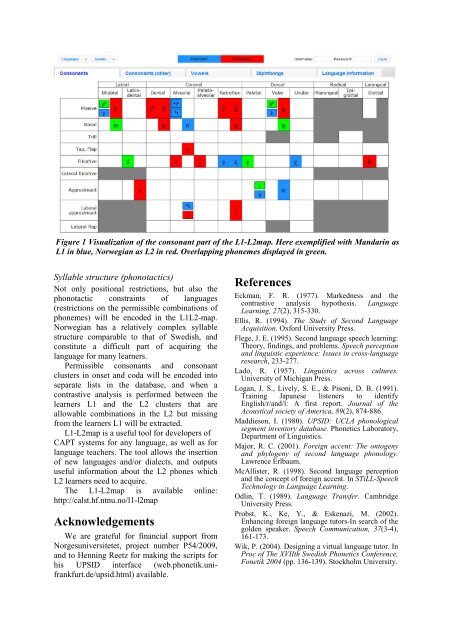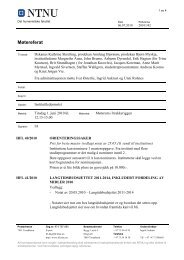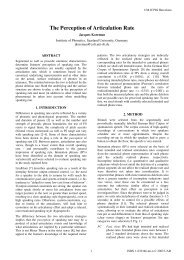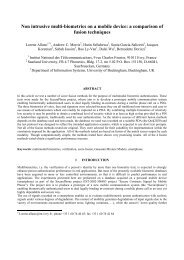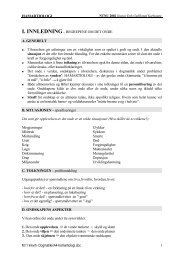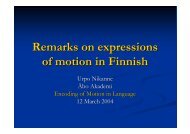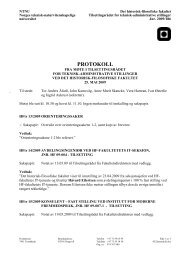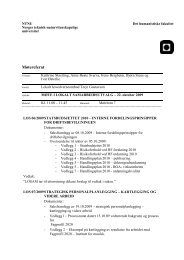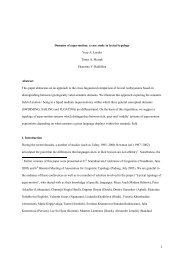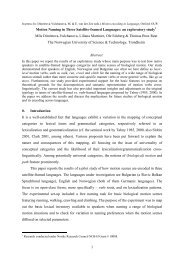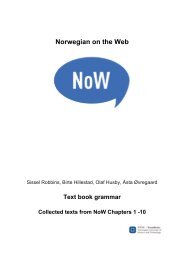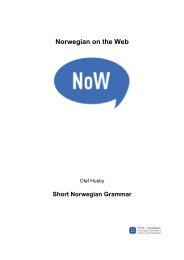Contrastive analysis through L1-L2map - NTNU
Contrastive analysis through L1-L2map - NTNU
Contrastive analysis through L1-L2map - NTNU
You also want an ePaper? Increase the reach of your titles
YUMPU automatically turns print PDFs into web optimized ePapers that Google loves.
Figure 1 Visualization of the consonant part of the <strong>L1</strong>-<strong>L2map</strong>. Here exemplified with Mandarin as<br />
<strong>L1</strong> in blue, Norwegian as L2 in red. Overlapping phonemes displayed in green.<br />
Syllable structure (phonotactics)<br />
Not only positional restrictions, but also the<br />
phonotactic constraints of languages<br />
(restrictions on the permissible combinations of<br />
phonemes) will be encoded in the <strong>L1</strong>L2-map.<br />
Norwegian has a relatively complex syllable<br />
structure comparable to that of Swedish, and<br />
constitute a difficult part of acquiring the<br />
language for many learners.<br />
Permissible consonants and consonant<br />
clusters in onset and coda will be encoded into<br />
separate lists in the database, and when a<br />
contrastive <strong>analysis</strong> is performed between the<br />
learners <strong>L1</strong> and the L2 clusters that are<br />
allowable combinations in the L2 but missing<br />
from the learners <strong>L1</strong> will be extracted.<br />
<strong>L1</strong>-<strong>L2map</strong> is a useful tool for developers of<br />
CAPT systems for any language, as well as for<br />
language teachers. The tool allows the insertion<br />
of new languages and/or dialects, and outputs<br />
useful information about the L2 phones which<br />
L2 learners need to acquire.<br />
The <strong>L1</strong>-<strong>L2map</strong> is available online:<br />
http://calst.hf.ntnu.no/l1-l2map<br />
Acknowledgements<br />
We are grateful for financial support from<br />
Norgesuniversitetet, project number P54/2009,<br />
and to Henning Reetz for making the scripts for<br />
his UPSID interface (web.phonetik.unifrankfurt.de/upsid.html)<br />
available.<br />
References<br />
Eckman, F. R. (1977). Markedness and the<br />
contrastive <strong>analysis</strong> hypothesis. Language<br />
Learning, 27(2), 315-330.<br />
Ellis, R. (1994). The Study of Second Language<br />
Acquisition. Oxford University Press.<br />
Flege, J. E. (1995). Second language speech learning:<br />
Theory, findings, and problems. Speech perception<br />
and linguistic experience: Issues in cross-language<br />
research, 233-277.<br />
Lado, R. (1957). Linguistics across cultures.<br />
University of Michigan Press.<br />
Logan, J. S., Lively, S. E., & Pisoni, D. B. (1991).<br />
Training Japanese listeners to identify<br />
English/r/and/l: A first report. Journal of the<br />
Acoustical society of America, 89(2), 874-886.<br />
Maddieson, I. (1980). UPSID: UCLA phonological<br />
segment inventory database. Phonetics Laboratory,<br />
Department of Linguistics.<br />
Major, R. C. (2001). Foreign accent: The ontogeny<br />
and phylogeny of second language phonology.<br />
Lawrence Erlbaum.<br />
McAllister, R. (1998). Second language perception<br />
and the concept of foreign accent. In STiLL-Speech<br />
Technology in Language Learning.<br />
Odlin, T. (1989). Language Transfer. Cambridge<br />
University Press.<br />
Probst, K., Ke, Y., & Eskenazi, M. (2002).<br />
Enhancing foreign language tutors-In search of the<br />
golden speaker. Speech Communication, 37(3-4),<br />
161-173.<br />
Wik, P. (2004). Designing a virtual language tutor. In<br />
Proc of The XVIIth Swedish Phonetics Conference,<br />
Fonetik 2004 (pp. 136-139). Stockholm University.


